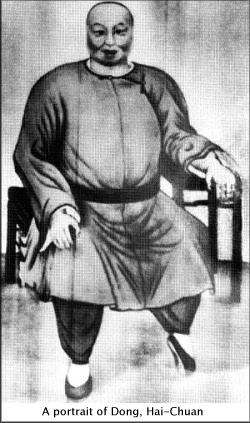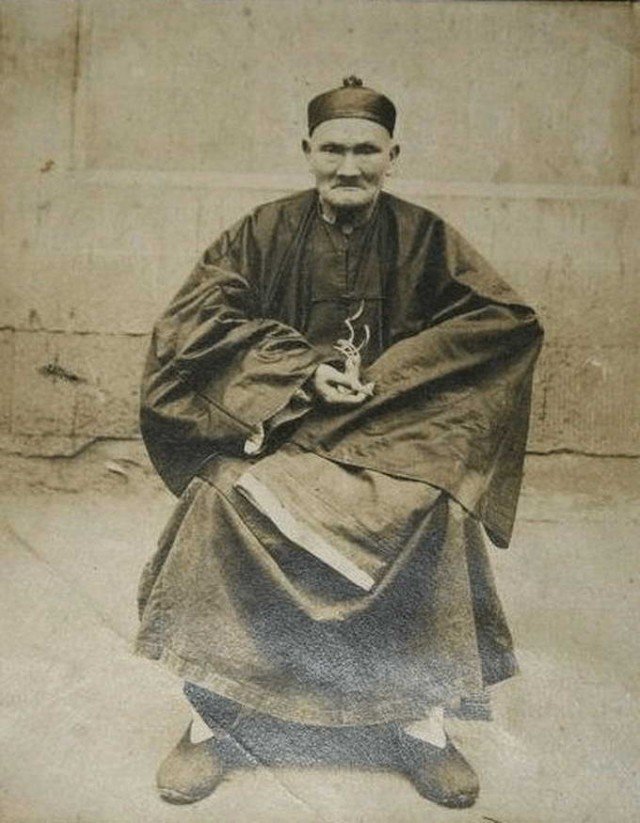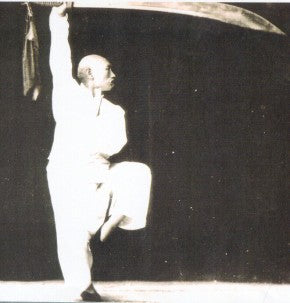History of Baguazhang

History of Baguazhang as presented by the World Budo Alliance as part of the preservation of martial art history project. Baguazhang or Pakua chang is one of the three main Chinese martial arts of the Wudang school.
And the other two being T'ai chi and Xing Yi Quan. And It is more broadly grouped as an internal practice (or neijia quan). Bāguà zhǎng literally means "eight trigram palm". Of which is referring to the bagua "trigrams" of the I Ching (Yijing), one of the canons of Taoism.
History of Baguazhang
The creation of Baguazhang as a formalized martial art, is attributed to Dong Haichuan (董海川), who is said to have learned from Taoist and Buddhist masters in the mountains of rural China during the early 19th century.
Many Chinese authorities do not accept the Buddhist origin, instead maintaining that those teachers were purely Taoist in origin. Most of all the evidence lying in Baguazhang's frequent reference to core concepts central to Taoism. Such as Yin and Yang theory, I Ching and Taoism's most distinctive paradigm, the Bagua diagram.
The attribution to Buddhist teachers came from the 2nd generation teachers, i.e. Dong Haichuan's students, some of whom were Buddhist. There is evidence to suggest a synthesis of several pre-existing martial arts taught and practiced in the region in which Dong Haichuan lived. Thus combined with Taoist circle walking.
History of Baguazhang
More History of Baguazhang. Through his work as a servant in the Imperial Palace he impressed the emperor with his graceful movements and fighting skill. And became an instructor and a bodyguard to the court. Dong Haichuan taught for many years in Beijing, eventually earning patronage by the Imperial court.
Famous disciples of Dong Haichuan to become teachers were Yin Fu (尹福), Cheng Tinghua (程廷華), Ma Gui (馬貴), Song Changrong (宋長榮). Liu Fengchun (劉鳳春), Ma Weiqi (馬維棋), Liu Baozhen (劉寶珍), Liang Zhenpu (梁振蒲) and Liu Dekuan (劉德寛).
Although they were all students of the same teacher, their methods of training and expressions of palm techniques differed. And the Cheng and Liu styles are said to specialize in "pushing" the palms. And the Yin style is known for "threading" the palms. Plus Song's followers practice "Plum Flower" palm technique. And Ma style palms are known as "hammers."
History of Baguazhang
Most of all some of Dong Haichuan's students, including Cheng Tinghua, participated in the Boxer Rebellion. And in general, most bagua exponents today practice either the Yin (尹), Cheng (程), or Liang (梁) styles.
In addition, there are sub-styles of the above methods as well, such as the Sun (孫), Gao (高), and Jiang (姜) styles, which are sub-styles of Cheng method.
"Only a fool tries to become his father in every way. Those who wave the flag of history to impress others are trying to cover up their fear. So be silent, stop looking for the waving flag and make the art of your teacher your own." - Li, Longdao.
History of Baguazhang - Li, Ching-Yuen

Taoist Master Li, Ching-Yuen is said to have created Nine Dragon Baguazhang while studying at Emei Mountain in Sichuan Province. Most importantly is Li, Ching-Yuen was a controversial figure who was reputed to have lived to be one of the oldest men in the world. And he claimed to have learned about longevity from another Taoist he met on the Emei Mountain in Sichuan province near the Tibetan border.
The monk, according to Li, Ching-Yuen’s story, was well over 300 years old And he was as agile as a monkey, as strong as a tiger and as wise as a dragon. It is wise to remember the Chinese love their tall tales. And take every opportunity to exaggerate a good story often to and beyond it’s credible limits.
Most of all this ancient Taoist sage reputedly instructed Li, Ching-Yuen in his secret method of health nourishing martial art exercises based upon the wisdom of the Book of Changes (Yijing). Most likely this was a Taoist of the Long-Men sect who practiced a method of circle walking meditation. Thus combined with chanting and visualization. The art of Li, Ching-Yuen came to be knows by the Li family as Jiulong Baguazhang. (Nine Dragon Eight Diagram Palm).
Important is that Li, Ching-Yuen was a scholar of Taoism and the Yijing. And he worked many years to create a method that contained strong emphasis on developing physical power through specific mind / body exercises. Plus his method was to produce first (Waigong) external strength and then (Neigong) Refined mind /body power. And which done in conjunction with developing the powers of the mind. Thus for the production of heightened life force (Qi) energy and longevity. It was truly a complete holistic system.
Let's continue the History of Baguazhang.
History of Baguazhang
On this subject of history and lineage concerning Li, Ching-Yuen and his Baguazhang methods there is much debate. Due to the lack of credible written histories no one will ever know all of the story. Although there are specific stylistic differences and methods of instruction And it is now believed that the Li family system of Baguazhang possibly has the same roots as other Baguazhang systems from the Dong, Hai-Chuan lineage that developed in Beijing.
However because this system was taught to only a very few members of the Li family, a clan of professional bodyguards operating in Sichuan Province, the connection to Dong, Hai-Chuan’s Baguazhang by lineage is obscure. Many claims are made and stories told. And those who did know for sure, old time masters who were students of Dong, Hai-Chuan, Li, Zhang Lai, Li, Ching-Yuen have now passed on.
American instructor John P. Painter of Arlington Texas learned this art from Mr. Frank Li (Li, Longdao) of Sichuan Province. Of whom was the last living master of the Taoqiquan internal family system and, like his father, a professional bodyguard.
Mr. Li was also known to be a doctor of traditional Chinese healing and a scholar of the Yijing. So Jiulong Baguazhang training also included philosophical studies of the Taoist classics. And also meditation concepts, massage, herbs, acupressure and other healing modalities to supplement the martial training.
History of Baguazhang

More History of Baguazhang: Most of all Mr Li told Dr. Painter that Li, Ching-Yuen’s methods of Baguazhang were refined by Mr. Frank Li’s grandfather, Master Li, Zhang-Lai. And who was said to have been one of the few students of Li, Ching-Yuen’s Jiulong Baguazhang during the late 1800’s in Sichuan Province.
Because the Li families were bodyguards, they were only interested in what was practical. They rejected much of the so-called magical skills often associated with “quack” boxers of this period as being impractical. Methods that would ensure strength, health, longevity, tactical skill in battle and fighting prowess were most important.
History of Baguazhang
This made for an art that would undergo continuous change and distillation, weeding out the esoteric and extracting the practical.
Dr. Painter believes that the history of all Baguazhang is but a “pale shadow of the truth” and that it is more important to practice one’s art faithfully than to worry about historical authenticity.
He says, “If the methods work and produce the promised results in the student that is all that truly matters.” Painter believes that over the years the Li family adapted many concepts into their Taoqiquan practice and that also goes for the Li, Zhang Lai version of Nine Dragon Baguazhang. I cannot say I personally agree with him here. While physical practice is most important, history while perhaps more folklore is also critical. If we do not know where we are from we cannot know where we are going.
History of Baguazhang - Origins of the Baguazhang
Most important Baguazhang was invented by Chinese martial arts expert Doug Haichuan in the early 1800's. And according to reports, Haichuan embarked upon a journey in the rural Chinese mountains to seek self-enlightenment. During his journey, he came across Taoist and Buddhist monks who taught him martial arts, including swordsmanship.
Haichuan was later hired as a bodyguard for the Chinese emperor. It's safe to say he left a strong impression thanks to its unparalleled martial arts skills. This prompted Haichuan to teach martial arts to other aspiring practitioners, some of whom would later go on to open their own martial arts schools.
History of Baguazhang - The Mechanics of Baguazhang
The defining characteristic of Baguazhang is a body movement or technique called circle walking. Also known as "turning the circle," circle walking involves moving one's body in a circular motion while maintaining a low posture. The practitioner essentially walks around the edge of an invisible circle while keeping his or her body low to the ground.
The size of this invisible circle varies depending on the practitioner's skill. Newcomers to Baguazhang often use a small circle that's just 6 feet in diameter. Experienced practitioners, on the other hand, use a large circle that's 12 feet or bigger in diameter. Larger circles such as this provide practitioners with more room in which to perform their circle walking. However, it also means means that practitioners must be conscious of the invisible boundaries of the circle.
History of Baguazhang
Practitioners of Baguazhang use a variety of weapons when performing this traditional Chinese martial art. Among the most common is the bagua jian, a large crescent-shaped sword with a live blade. And while walking around the perimeter of an invisible circle, practitioners gracefully swing the bagua jian over their head and in front of their body. In addition to the bagua jian, other common weapons used in Baguazhang include deer horn knives, staves, spears, canes, flails and broadswords.
Comment: I find it interest that today people view history as having no value, or that because of inaccuracy it should be discarded. Yet these same people will listen and watch as the mainstream media, governments, and science lie to them non stop. History is something we learn from. And learning is the most important thing people can do. All of the issues founded today in the failed Western Culture, and YES IT HAS FAILED. Are from our refusal to learn, understand and not repeat history.
History of Baguazhang Researched by Sensei Kara Borshuk
History of Baguazhang Edited by Grand Master Art Mason